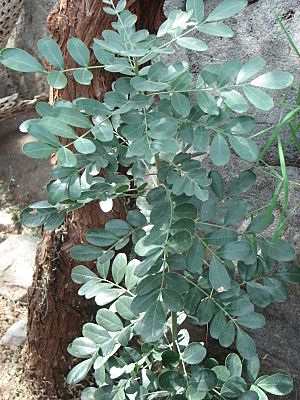Olneya facts for kids
Quick facts for kids Olneya |
|
|---|---|
 |
|
| Scientific classification | |
| Kingdom: | |
| (unranked): | |
| (unranked): | |
| (unranked): | |
| Order: | |
| Family: | |
| Subfamily: | |
| Tribe: |
Robinieae
|
| Genus: |
Olneya
A. Gray
|
| Species: |
O. tesota
|
| Binomial name | |
| Olneya tesota A.Gray, 1854
|
|
 |
|
| Natural range | |
The Olneya tesota is a special kind of tree that blooms with flowers. It is also known as the ironwood or desert ironwood. In Spanish, people call it palo fierro. This tree is the only species in its group, called Olneya.
You can find the desert ironwood tree in the western Sonoran Desert. This desert is in the Southwestern United States. Other plants that live there include palo verde, saguaro cacti, ocotillo, and mesquite trees.
Contents
What Does the Desert Ironwood Look Like?
The desert ironwood can grow as a bush or a tree. It can reach about 10 meters (33 feet) tall. Its trunk can be about 60 centimeters (24 inches) wide. In special places like large, protected dry riverbeds, it can grow even taller and wider.
When the tree is young, its bark is gray, shiny, and smooth. As it gets older, the bark becomes rough and broken. The desert ironwood is an evergreen plant. This means it usually keeps its leaves all year. However, it might lose its leaves if the temperature drops below 2 degrees Celsius (36 degrees Fahrenheit). It will also lose its leaves if there is a long period without rain.
Its leaves are a pretty bluish-green color. They are made up of smaller leaflets, like a feather. Each leaf is about 6 centimeters (2.4 inches) long. It has 6 to 9 small leaflets, each about 0.7 to 2.5 centimeters (0.3 to 1 inch) long. At the bottom of each leaf stem, there are two thorns. These thorns are about 1 centimeter (0.4 inches) long.
The desert ironwood blooms with flowers from late April or May to June. Its flowers have five petals. They can be purple, magenta-red, white, or light pink. After the flowers, seedpods grow. These seedpods are 5 to 8 centimeters (2 to 4 inches) long. They turn light reddish-brown when they are ready. Other desert trees, like the Blue palo verde and Catclaw Acacia, have similar seedpods. However, Catclaw Acacia seedpods are shorter and shaped like a "J."
Where Does the Desert Ironwood Grow?
The desert ironwood, Olneya, lives in the southwestern United States and the very northwestern part of Mexico. This includes the Baja California Peninsula and the Sonoran Desert. It is a special plant that helps show where the Sonoran Desert is.
In Mexico, you can find it in the states of Baja California Sur, Baja California, and Sonora. In the southwestern US, it grows in the Colorado Desert in southeastern Southern California. It also grows in western and southern Arizona. The Olneya does not grow in the colder, higher parts of Arizona's Sonoran Desert.
The Ironwood Forest National Monument in Arizona is named after this amazing tree.
An Indicator Species
The Olneya tesota is called an indicator species for the Sonoran Desert. This means that if you see this tree, you know you are in the Sonoran Desert. There is another species that lives in the exact same area: the lesser long-nosed bat. This bat travels from south to north, following the blooming flowers of different plants. It goes to the same parts of the Sonoran Desert as the Olneya tree.
In the northern part of its range, both the tree and the bat help define the Colorado Desert. This area is a part of the Sonoran Desert around the northern end of the Gulf of California. Further south in the Baja California Peninsula, the desert is called the Vizcaino Desert.
The bats spend their winters and live permanently in the northern countries of Central America.
Desert Ironwood and Other Living Things
The sweet-tasting sap from the desert ironwood is a treat for bees and hummingbirds. However, a bird called the silky-flycatcher (or phainopepla) can cause a problem for the tree. When these birds eat mistletoe berries, they drop the seeds in the cracks of the Olneya tesota tree. The mistletoe then grows on the ironwood tree and takes nutrients from it, like a parasite.
Uses of Ironwood
The seeds of the desert ironwood can be eaten after they are roasted.
The wood from the Olneya tree is very hard and heavy. It is so dense that it sinks in water! Because of this, it does not float down rivers or washes.
It is very difficult to cut or shape desert ironwood because it is so hard. Also, it is hard to treat the wood with solutions because it is so dense. This means it's not easy to process this wood in large amounts. Most of its uses are for special, handmade items. People use it to make beautiful wooden sculptures and strong knife handles.
See also
 In Spanish: Olneya para niños
In Spanish: Olneya para niños



